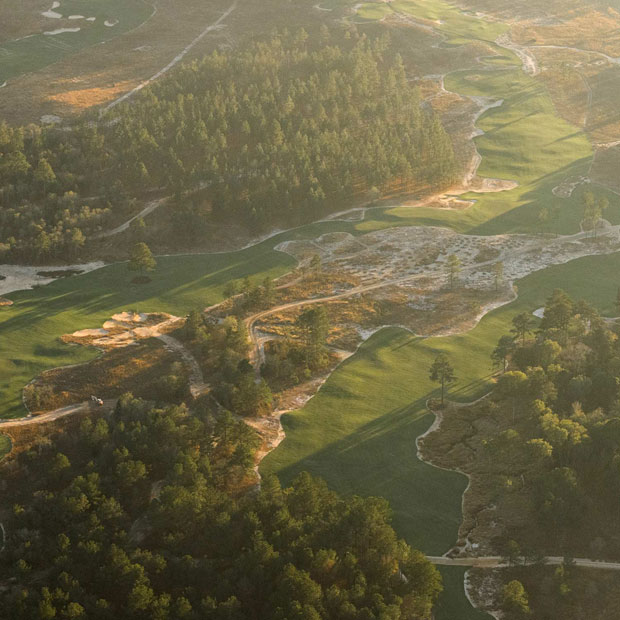Eclectic 18 UK – Hole No. 10, St. George’s Hill
An analysis of the 10th hole at St. George’s Hills Golf Club


After three straight links holes to close out the front nine, the outward half of the Eclectic 18 UK begins with a semi-blind tee shot just steps from the terrace of the red brick castle that St. George’s Hill Golf Club calls a clubhouse. British golf courses may be known for their quaint clubhouses, but this one in London’s posh suburb of Weybridge could have hosted a medieval jousting competition. What it presides over today is Harry Colt’s best work in Surrey. And for our money, Colt’s “best” trumps his “least bad”!*
(*Harry Colt famously referred to Swinley Forest as his “least bad golf course.”)
The clubhouse is far from the only mansion you will see at St. George’s Hill. This 27-hole facility was one of golf’s earliest real-estate ventures, and now home to a rather long list of celebrities, footballers, and Russian oligarchs.
If you fancy famous golf holes over famous people, however, there are plenty of the former at St. George’s Hill. The 8th hole on the Red course, which graces the cover of Robert Hunter’s The Links, has rightfully become most famous. If it were restored to its former glory, the mid-length par 3 would be a strong contender to knock off the Postage Stamp for the eighth slot in our Eclectic 18.

The photo of the 8th hole at St. George's Hill that appears on the cover of Robert Hunter's 1926 book The Links
Back in Hunter and Colt’s time, this stunning par 3 was far more rugged. Like its brother, the 5th at Sunningdale, it would have revealed itself in a most dramatic fashion after the early tree-lined holes. Similarly, once you cross the valley and arrive at the 8th green, you get a long view up the 9th to the clubhouse just as stunning as Sunningdale’s sprawling tract of heath.
After the Red course, which serves as the front nine in St. George’s Hills’ championship routing, the Blue course and our Eclectic 18’s back nine begins with the stellar 10th hole. This long par 4—or what Fried Egg Andy might call a par “four and a half”—starts with a tee shot over a heathery expanse to a generous fairway. You can see some short grass from the tee, but the landing area and a big dip in the fairway are hidden. The second shot plays over a sandy ridge that bisects the fairway and trails off into a string of bunkers that lead to the right corner of the green.
{{content-block-eclectic-18-uk-st-georges-hill-001}}

An aerial view of the 10th hole at St. George's Hill (Google Earth)
Since the semi-blind fairway runs downhill and left to right, placing your tee shot in the proper place is a difficult task. But it does not get any easier on the second shot, which you must hit up and over the hazards that Colt has strung across the fairway. The green and approach continue to tumble downhill and left to right, making a bouncing cut both the ideal way to approach the green and the shot type most susceptible to the well-placed hazards. This is where Colt really hits the nail on the head with his bunkering scheme and green design, both of which emphasize the strategy suggested by the land.
A bare sliver of fairway to the right offers the possibility of a layup. Golfers who take this path can open up the green visually between the bunkers and use the angle to play their third shot more into the slope of the severe putting surface. It is easy to wonder whether the fairway here were originally wider and more conducive to strategic layups of this type.
The two-tiered green that Colt carved into the natural amphitheater is one of his best. Partially obscured from the fairway, this putting surface flows out of the high landforms on the left. With steep banks around it, the higher left tier of the green almost looks like a punchbowl and therefore begs for a running shot. More often than not, however, the severe slope down off of the tier to the right will collect your ball. That’s not the end of the world, though; an uphill putt is easier than stopping a downhill one.
{{content-block-eclectic-18-uk-st-georges-hill-002}}
Later, Colt offers one last glimpse of this famed green as you play the 17th back past the 10th on the tough finishing stretch of the Blue course. It’s a long climb back to the castle, but once you have slayed this dragon, be sure to bring home a souvenir with one of golf’s best logos on it.
Eclectic 18 UK is the brainchild of golf course architects Jaeger Kovich and Clyde Johnson. Read more about the series here, and follow Jaeger and Clyde on Instagram.
Leave a comment or start a discussion
Engage in our content with thousands of other Fried Egg Golf Club Members
Engage in our content with thousands of other Fried Egg Golf Members
Get full access to exclusive benefits from Fried Egg Golf
- Member-only content
- Community discussions forums
- Member-only experiences and early access to events












Leave a comment or start a discussion
Lorem ipsum dolor sit amet, consectetur adipiscing elit. Suspendisse varius enim in eros elementum tristique. Duis cursus, mi quis viverra ornare, eros dolor interdum nulla, ut commodo diam libero vitae erat. Aenean faucibus nibh et justo cursus id rutrum lorem imperdiet. Nunc ut sem vitae risus tristique posuere. uis cursus, mi quis viverra ornare, eros dolor interdum nulla, ut commodo diam libero vitae erat. Aenean faucibus nibh et justo cursus id rutrum lorem imperdiet. Nunc ut sem vitae risus tristique posuere.